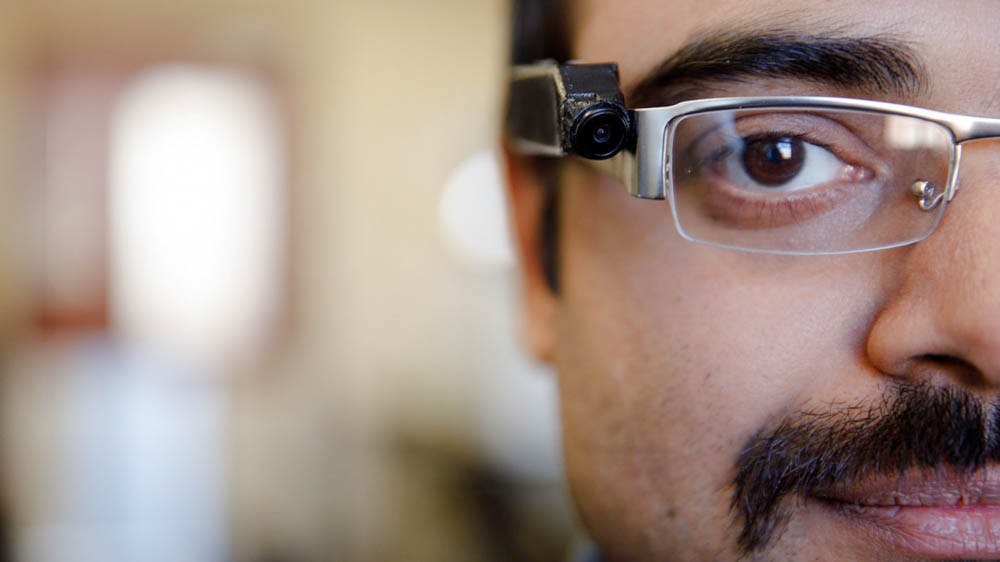To test the effectiveness of the Automatic Ingestion Monitor — a wearable device that monitors human eating behavior through an individualized approach using a chewing sensor and camera — a team led by researchers from the University and the University of Alabama will begin clinical trials funded by the National Institutes of Health.
Leading the team, Associate Professor of Psychiatry and Human Behavior Graham Thomas and Professor Edward Sazonov at the University of Alabama will attempt to determine whether the AIM can help modify eating behavior in overweight and obese patients.
AIM is similar to a Bluetooth earpiece that people wear over their ears to make phone calls, Thomas, a co-principal investigator of the study, said. “It’s similar in size, but it attaches to the side of glasses.” The sensor in the device detects the contraction of the temporalis muscle, the muscle right above the ear.
This contraction can allow scientists to detect different types of muscle activity. For example the contraction “is very good to distinguish chewing activity from … talking, yawning or any other physical activity,” Sazonov said.
The device also features an attached camera that photographs the food that’s being eaten. Through the data obtained from the camera and sensors, the team is able to learn different aspects of a person’s eating behavior, including the “timing of eating, duration of eating (and the) microstructure of eating, such as eating slow, fast or taking pauses in between,” Sazonov said. These images provide further information about nutrition, meal sizes and calorie consumption, he added. The researchers’ goal is for users of the device to receive real-time feedback to help them modify their eating behavior.
To do so, the device sends interventions to users by connecting to their smartphones through Bluetooth, Thomas added.
“This device has the potential to provide important feedback to people and may be able to help them with weight control,” Ariana Chao, medical director for the Center for Weight and Eating Disorders and associate professor at the University of Pennsylvania, wrote in an email to The Herald.
While former studies proved the efficacy of the device for measurement,“this project is a clinical trial to test its capacity as an intervention tool,” Sazonov said.
The team plans on doing two types of intervention with the data obtained from the AIM. “The first kind will try to control the number of calories somebody eats in a day,” Thomas said. After determining how much a person can consume while still remaining under the daily calorie consumption goal, messages from the smartphone will notify its user when to stop eating.
The other intervention focuses on controlling users’ tendencies to eat too quickly. This problem is “very common” among people who are overweight and obese, Thomas said. “Intervention will help folks slow down their eating and help pay attention to their body’s signals about how full or hungry they are.”
The team also recognized that a single, uniform approach would not be effective in a field like this. “One of the key issues is personalization. Our system takes time to observe a person’s behavior. Any two people are probably not eating alike. They may eat at different times; they may have different food preferences,” Sazonov said.
The process of preparing for the clinical trials in this four-year study began about four to five months ago, and the researchers “expect to enroll patients in February or March,” Thomas said.
The purpose of this clinical trial is to observe the immediate effects of these interventions and to see if people are responsive to this guidance, he added.
“We hope to learn whether delivering this kind of personal feedback is beneficial in changing eating behavior, reducing calories consumed (and) helping weight loss. If it does, we want to introduce it to clinical practice,” Sazonov added.
One of the known obstacles for weight control methods is the effort needed to manually track food consumption. “Typically, I counsel patients who are seeking obesity treatment to monitor their food intake using paper food logs or food tracking apps. While effective, patients may find these approaches burdensome,” Chao wrote.
“We want to take the burden off of people and make it easier for them to make decisions around eating for weight management. … We want to provide them with accurate information so that they can focus their efforts on making healthy decisions versus the minutia of tracking everything they eat in great detail,” Thomas said.





